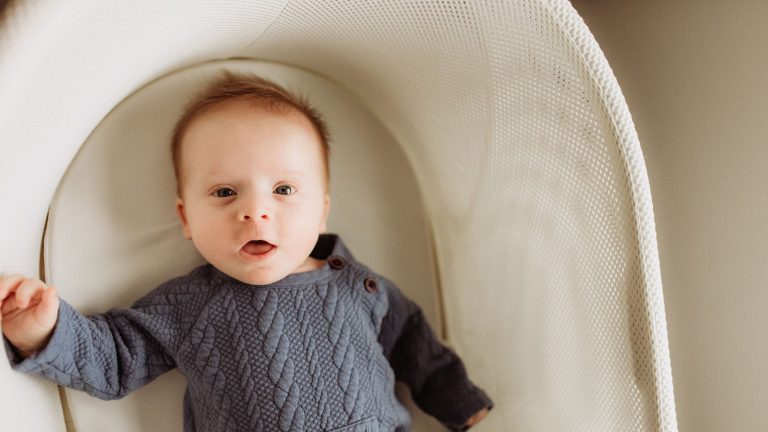
Cradle Vs Bassinet: Which is Best for Your Baby?
- Created:
28. 3. 2023 - Updated:
18. 10. 2023
Now:
When it comes to choosing an infant sleeping product, it can be overwhelming.
But fear not.
In this post, I am comparing cradles with bassinets to help you identify what’s best for your little one.
The post goes into detail on how the two sleep products compare in terms of features, performance, safety, and price.
Let’s kick things off!
Cradle Vs. Bassinet – What’s The Difference?
The main differences between a cradle and a bassinet are the rocking feature, size, and design. A cradle is a little bigger than a bassinet but smaller than a crib. Unlike bassinets, cradles often have an arched footboard that allows for the rocking or swinging motion feature.
Bassinet Vs. Cradle – Comparison Table
| Bassinet | Cradle | |
|---|---|---|
| Purpose | A small portable bed for newborns | A small bed for newborns |
| Popularity | More popular than cradles | Less popular than bassinets |
| Size | Smaller than a cradle and crib | Larger than a bassinet but smaller than a crib |
| Recommended age | From birth to 6 months | From birth to 6 months |
| Weight range | 15 to 20 lbs. | 15 to 30 lbs. |
| Usage | Mostly placed in the parent’s bedroom. | Mostly placed in the baby’s nursery |
| Material | Metal, wood wicker, or wooden frame.Fabric on the sides | Most cradles are made of wood.Some cradles have upholstered sides |
| Portability | More portable and travel-friendly | Less portable. Not travel friendly |
| Regular | Regulaed by the US Safety Standard for Bassinets and Cradles | Regulated by the US Safety Standard for Bassinets and Cradles |
| Rocking motion | May or may not have the ability to rock or sway | Designed to rock or sway back and forth |
| Stability | Less stable | More stable and sturdier |
| Durability | Less durable | More durable |
| Safety | Safe | Safe |
| Storage | Some models have storage space underneath or on the sides | Generally does not have any storage space |
| Assembly | Easy to assemble | Requires more assembly than a bassinet |
| Price | $50 to $700 Luxury models cost up to $2000 | $50 to $300 |
12 Differences Between A Bassinet and Cradle
1. History
Now:
Both the cradle and the bassinet have been around for a while.
From their documented history, cradles are one of the oldest infant sleep products.

Interestingly, the earliest cradles were made out of hollowed-out logs and Italian whiskey barrels.
But there was a problem.
Cradles were usually placed on the ground, exposing the babies to cold and animals.
And that is how the bassinet was invented: as a raised cradle to protect babies from cold and animals.
The bassinet then led to the crib when babies started crawling out of the bassinet.
Over the years, bassinets and cradles have been refined and polished to look and function better. Most of the significant improvements have happened within the last three decades.
As we’ll see later, bassinets have undergone the most changes.
For the cradles, the traditional design has remained the most popular. This is evident from the heirloom and vintage cradles, which look very similar to the modern cradles.
Fun fact:
The slats on cribs and cradles were designed to let mothers breastfeed the child without picking them out.
2. Popularity
So:
What’s more popular between bassinets and cradles?
Without a doubt, bassinets are more popular than cradles.
Why? You may ask.
While the two are different in terms of construction and design, they serve the same purpose and are quite similar.
First, most babies outgrow them between the third and fourth month.
Secondly, they have similar weight limits and are in the same price range.
But there is something that makes bassinets a favorite among many parents: lightweight construction.
This makes bassinets easy to carry around and travel-friendly. The only areas where cradles triumph over bassinets are stability and sturdiness.
A 2005 survey found that 64% and 18% of newborn parents owned bassinets and cradles, respectively.
3. Types
| Types of bassinets | Types of cradles |
|---|---|
| 1. Standard bassinets | 1. Traditional cradles |
| 2. Bedside bassinets | 2. Modern cradles |
| 3. 2-in-1 or 3-in-1 bassinets | 3. Heirloom cradles |
| 4. Gliding bassinets, rocking bassinets, and vibrating bassinets | 4. Convertible cradles |
| 5. Travel bassinets – portable bassinets | 5. The Moses basket |
| 6. Luxury bassinets | 6. Convertible cradles |
Now:
There are different types of bassinets depending on the design. These types include:
1. Standard Bassinets
Now:
The standard bassinets were the first successful commercial bassinets. They were and are still basic, without a lot of bells and whistles.

These bassinets have an aluminum or plastic frame to keep them lightweight. Most of them also feature a quick-folding mechanism. This makes it pretty easy to transport, store and set them up.
The standard feature for these bassinets is the inverted V base design and the dome canopy.
2. Bedside Bassinet
The second type is the bedside bassinets. They are also known as “co-sleepers,” which is a bit controversial.
Why?
Co-sleeping with a baby is not recommended, as it increases the risk of SUDI ( Sudden Unexpected Death in Infancy). Luckily, these bassinets are actually not for co-sleeping.
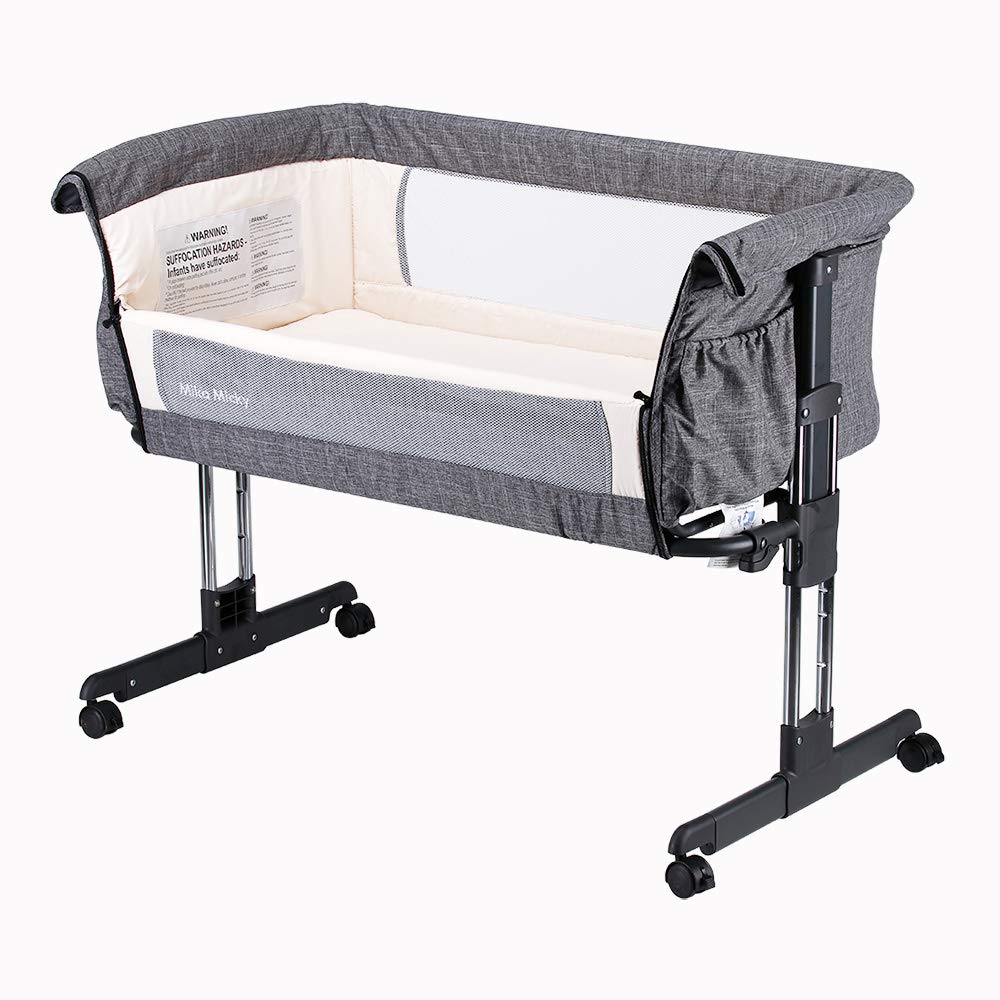
Bedside bassinets feature a mechanism to attach to the parent’s bed. This is mostly done using straps to attach to a bed.
This setup makes it easier to access and watch the baby when they are sleeping.
Bedside bassinets have a drop-down side that you unzip when you are feeding or checking on the baby.
These bassinets should be used carefully to prevent the danger of a baby getting trapped or falling out from the drop-down side.
3. 2-In-1 Or 3-In-1 Bassinets
Now:
2-in-1 and 3-in-1 bassinets refer to bassinets that convert into different baby products. It’s basically, several baby products combined into one.
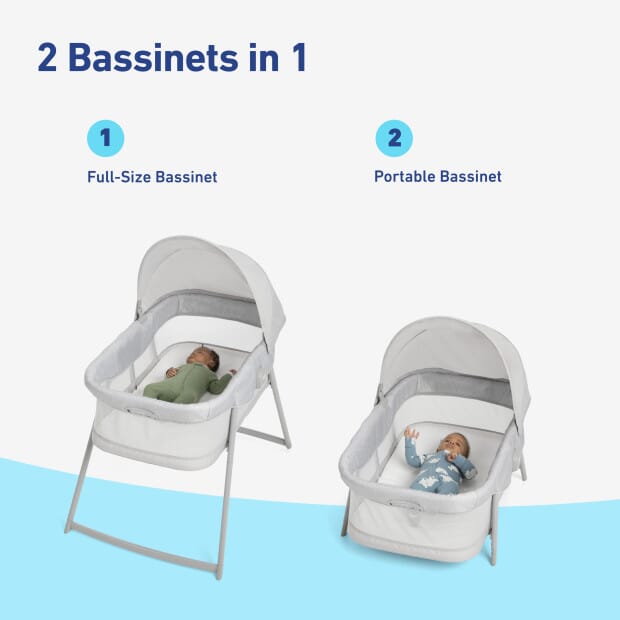
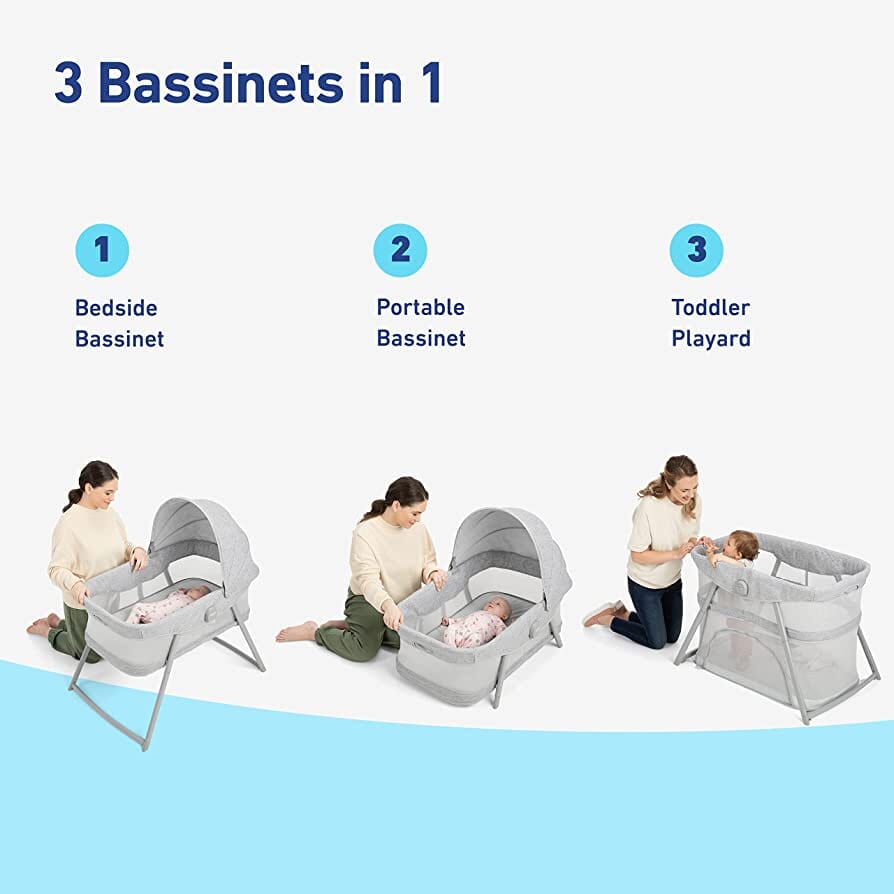
Examples of 2-in-1 bassinets include
- Models that convert into a bedside sleeper
- Bassinets that convert into a playpen
- Models that fold into a compact traveling bassinet.
4. Gliding Bassinets, Rocking Bassinets, and Vibrating Bassinets
This category is for bassinets that can glide, rock, or vibrate to help soothe a baby.
Gliding bassinets imitate the swaying motion you make when holding a baby.
Rocking bassinets, on the other hand, move in a side-to-side motion similar to the traditional cradle motion.
Note:
The type and design of the rocking or gliding mechanism vary between models.
Some models rock or glide automatically when the baby moves or cries. Others have a switch that you press when you want to rock the baby.
5. Travel Bassinets
Now:
Travel bassinets bring along the convenience of a bassinet when you are traveling with an infant.
They have a quick folding mechanism and are lightweight, letting you pack them easily when visiting family or friends who may not have the right baby gear.
These bassinets come with a carrying bag for added convenience. They are also very convenient when going on a vacation or a trip.
6. Luxury Bassinets
Manufacturers are using technology to invent the best and most luxurious bassinets.
As you’d expect, this class of bassinets has a higher price tag. Luckily, you get features and functions that you cannot find on most other bassinets.
A good example of a luxury bassinet is the SNOO Smart Sleeper Bassinet, which costs about $1700.
This bassinet promises to sleep-train your baby. It automatically responds when the baby makes slight movements or sounds. On top of that, you can control it via a remote.
Types of Cradles:
1. Standard Cradles
Now:
If there is a baby product that has stood the test of time, it’s the traditional cradle. This design has remained unchanged for a very long time.
Why?
Frankly speaking, why would you fix something that is not broken?

The standard cradle looks very similar to a crib except for the legs.
The signature features of the standard cradle include
- Four freestanding legs
- Wood construction
- Wood slats on the sides
- A curved base
- Manual back-and-forth rocking mechanism
2. Heirloom Cradles
These are vintage cradles that have been passed down through the generations.
Despite looking usable, vintage cradles should not be used with babies.
That’s why you can’t find them on sale in baby stores.
Why?

They are not safe, as they don’t meet the latest cradles and bassinets safety standards.
Heirloom cradles are only available on online marketplaces such as eBay, Craigslist, and Facebook Marketplace.
3. Modern cradles
Just like with bassinets, manufacturers are introducing new styles of cradles.
For instance, you’ll find some modern cradles with a different base than the signature four legs. There are also cradle designs that have upholstery on the sides.
Despite the changes, it’s rare to find high-tech cradles. Most manufacturers stick with the traditional wooden style with a rocking base.

4. Convertible Cradles
Another type of baby cradle is the convertible cradles.
An example is models that convert from a rocking style to a non-rocking style.
Other cradles convert into a cot or a table.
5. Moses baskets
A Moses mounted on a rocking stand is classified as a cradle. If the stand is not rocking, it’s classified as a bassinet.
That’s why Moses baskets follow the same standards established for bassinets and cradles.
4. Designs
Now:
When it comes to bassinet designs you will be spoilt for choice, as they are available in tens of designs.
As manufacturers race to invent the crème de la crème bassinet, every manufacturer is coming up with unique designs to make their models stand out.
Most brands seem to focus majorly on the stand designs, materials, and technology, with very few changes to the bassinet itself.
New models are also doing away with the canopy or hood that is common on standard bassinets.
When it comes to cradles, there are very few designs. That’s why the traditional, timeless wooden design remains the most popular.
Also, almost all cradles have wooden slats on the sides and rock manually.
As I mentioned earlier, there are a lot of technological advancements happening in the bassinet arena. On the other side, it’s rare to find any technology in a cradle.
The Different Bassinet Designs
The Different Cradle Designs
Note:
The U.S. Consumer Protection Safety Commission (CPSC) banned the manufacturing and sale of drop-side cribs and cradles.
Other baby sleep products that have been banned include:
- Crib bumpers
- Any inclined sleeping surface greater than 10 degrees
- Any product for bedsharing with a baby
5. Construction
Now:
Bassinets have a frame made of metal, wood, wicker, or plastic. These materials keep the bassinet lightweight for easier moving.
The sides are usually covered with a soft, breathable material to facilitate air circulation. Some bassinettes have mesh sides so that you can keep an eye on the baby.
Unlike some cradles, all bassinets come with a mattress. The mattress is usually thin and firm so that the baby’s head doesn’t sink, which can lead to suffocation.
On the other side:
Except for a few cradles with upholstered sides, most cradles are made of wood only. The most commonly used types of wood in making cradles include oak, maple, ash, cherry, beech, and mahogany.
This construction makes them a bit heavier but sturdier than bassinets
6. Weight Limit, Age, And Size Limit
Now:
Most bassinets have a weight limit of between 15 and 20 pounds. There are, however, a few models that have a higher weight limit of up to 35 lbs.
These models are typically designed for large babies, who would outgrow the standard bassinets pretty fast.
On the other hand, most cradles have a weight limit of between 15 and 30 lbs. And just like with bassinets, a baby should transition from the cradle the moment they hit the weight limit.
Note:
Babies should also immediately transition to the crib when they start rolling over, sitting, or pushing with their hands and legs.
Remember:
While bassinets and cradles are designed for use from birth to around 6 months, most babies will outgrow them between 3 and 4 months.
That’s why you don’t require both of them. A baby can take all their day naps and night sleep in a bassinet or cradle.
7. Usage
Now:
Because cradles are a bit larger and heavier than bassinets, they are mostly put in the nursery. They can also be put in the parent’s room if there is enough space.
On the other hand:
Bassinets are primarily used in the parent’s room thanks to their small footprint. Since they are lightweight and most of them are foldable, they can be used pretty much everywhere.
8. Portability
When it comes to portability, bassinets are the clear winner. They are lighter, making them easier to move around the house.
There are also travel bassinets that can be folded during transportation. Others have removable legs, so you can place them on the floor.
9. Durability
Now:
Cradles are more durable because they are made of wood.
On the other hand, bassinets are made with a weaker metallic, wooden, or plastic frame. The fiber material on the sides of most bassinets is also prone to tearing.
10. Regulations
Both cradles and bassinets must comply with the Safety Standard for Bassinets and Cradles set by the Consumer Product Safety Commission (CPSC).
These CPSC regulations provide guidance on:
- The degree of incline on the sleeping surface
- How testing should be done
- The height of the sides
- The thickness of the sleeping surface
- The rocking angle for models with that feature
- How to indicate warnings
11. Technology
When it comes to technology, bassinets are more advanced.
Below are some features that you will find on some modern bassinets that you cannot find on modern cradles
- Sounds and noises to soothe the baby.
- A wide range of rocking motions.
- Bluetooth and WIFI functionality
- Nightlight feature
- Vibrating mode
- Automatic response to noise or movements
- Converting into a changing surface
- Inbuilt speakers and a microphone
- A built-in baby monitor
- A sleep tracker
One of the most advanced bassinets I have come across is the feature-packed Cradlewise Convertible smart crib, which converts from a bassinet to a crib.
12. Price
Now:
Most bassinets and cradles fall in the same price range of between $50 and $350. Because of technological advancements, there are more expensive luxury bassinets than luxury cradles.
Bassinets featuring some of the latest technologies cost as much as $2000.
Benefits and Drawbacks Of Bassinets
Pros
- Bassinets offer a safe means to room share with your baby without sharing a bed.
- They offer a convenient way to keep the baby close to you when you are sleeping or lounging.
- There are lightweight and foldable bassinets that are travel friendly.
- Most bassinets have a protective hood or canopy to cover the baby.
- Bassinets are very ideal when there is limited space in the bedroom.
- Most bassinets have storage options such as baskets or shelves for storing toys and clothes.
- Modern bassinets feature some of the best sleeping technologies
- Placing and picking the baby from the bassinet is easy
Cons
- A bassinet is a short-term bed as most babies outgrow them in 3 to 6 months.
- They have the risk of sleep-related deaths, if the product is not used well or if the product is faulty.
- Bassinets are getting expensive. Some bassinets cost as much as $2000
- The best features and technologies are only found on the high-end bassinets.
Benefits and Drawbacks Of Cradles
Pros
- Cradles are more stable and sturdier than bassinets.
- The wood construction is very stylish
- Cradles provide a safe way to keep the baby close.
- The side slats allow you to keep an eye on the baby.
- The rocking motion helps to soothe the baby
Cons
- They are heavier.
- Cradles are not travel friendly.
- It’s straining when putting or picking up the baby
- Most babies outgrow cradles from 3-6 months.
- They take up more space than bassinets.
- Cradles can only be used from one location, mostly the nursery.
- Most cradles don’t come with beddings.
- They are harder to store after the baby stops using them.
Which One To Buy?
If you are looking for a temporary and easy-to-move bed for your infant, then you are best suited with a bassinet.
When to buy a bassinet?
If you:
- Have limited space in your bedroom
- Are looking for an easy-to-store product when the baby outgrows it
- Want a travel-friendly bed for your baby
- Are a CS mom to minimize straining when placing or picking the baby
- Are looking for a technologically advanced baby bed
When should I buy a cradle?
If you:
- Want a more stable and sturdier infant bed.
- Have a spacious bedroom.
- Already have a bassinet.
- Love the wood aesthetics.
- Want a sleeping product with a slightly higher weight limit.
Bassinet and Cradle Safety Tips
- Don’t buy a second-hand bassinet or cradle
- Follow the safe sleep recommendations by the American Academy of Pediatrics
- Comply with the manufacturer’s weight, size, and age recommendations
- When buying either a bassinet or cradle ensure it complies with the Safety Standard for Bassinets and Cradles.
Final Tip: Annie Baby Monitor – Your Guardian for Independent Sleep
When your kiddo starts sleeping alone, you can rely on Annie Baby Monitor to keep an eye out and give you some peace of mind.
Just put the monitor in their room and stay connected through live video and audio monitoring.
With Annie and its motion and cry detection, you can be sure your little one is safe and sound as they start sleeping independently.
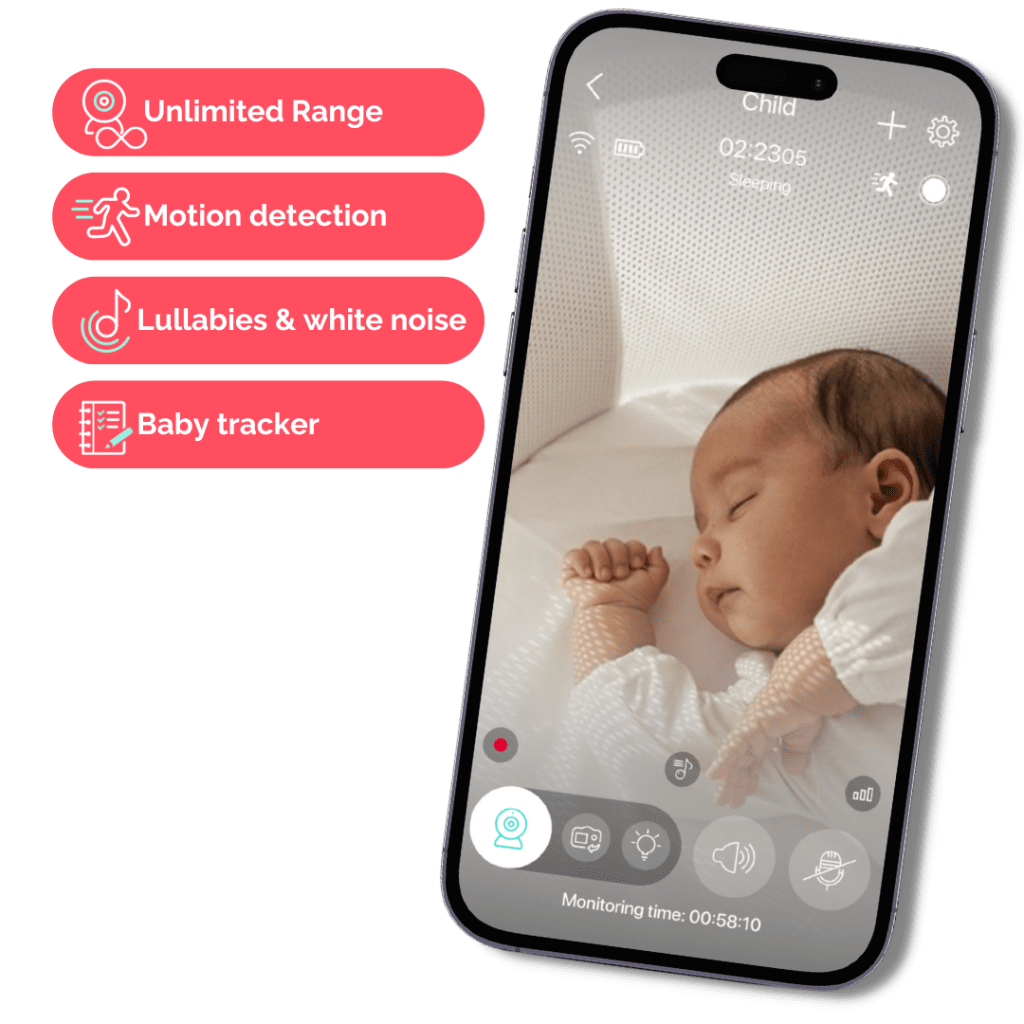
Looking for a top-notch baby monitor? Look no further than Annie Baby Monitor. It’s the perfect solution for keeping tabs on your little one. Check it out now.
Conclusion
A bassinet and cradle are two of the safest beds for infants aged between 0 and 6 months. The major differences between the two are the construction and features.
Cradles are primarily made of wood, which makes them heavier. This makes them less portable and not travel-friendly. On the other hand, most bassinets are lightweight, portable, and travel-friendly.
Because of their large footprint, cradles are mostly placed in the nursery, but bassinets are mostly put in the parent’s bedroom.
Frequently Asked Questions on Cradle Vs Bassinets
No, while they are both made for newborns aged between 0 and 6 months, bassinets are typically smaller than cradles.
Yes, cradles that adhere to the Safety Standard for Bassinets and Cradles are safe. Before buying one, check if they are certified.
Some of the must-have certifications include
JPMA Certification
CPSC
ASTM Standards
No, they are two different sleeping products for infants aged between 0 and 6 months. Most cradles are made of wood, while bassinets are made of metal, plastic, or wood frame and breathable fiber on the sides.
While you can have both of them, you actually don’t need both of them. They serve the same purpose, and babies stop using them around the same time. Also, each of them is a sufficient sleeping bed for all naps and nighttime sleep.






